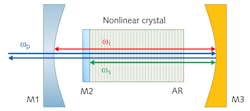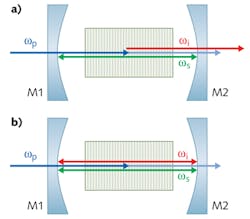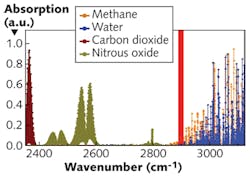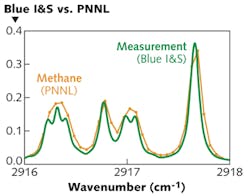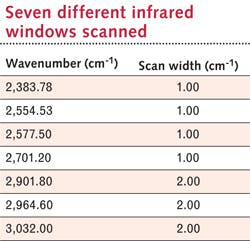Photonics Applied: Optical Sensing: OPO-based optical analyzer monitors multiple gases in real time
Gas measurement instrumentation is necessary to control and monitor industrial process in the oil and gas, chemical, pharmaceutical, and food industries. Under constraints to save costs and energy and to further reduce the emission of pollutants, these industries are continuously seeking more sophisticated gas-measurement techniques that provide real-time quantification of multiple gases from very low- to high-concentration levels.
While laser-based optical gas analyzers are a natural solution for real-time quantification of trace gases, it has been difficult to develop systems capable of measuring more than three to four gases accurately enough because of limited wavelength tunability (typically a couple of wavenumbers). However, a new gas analyzer based on an optical parametric oscillator (OPO) pumped by a pulsed microchip laser—capable of measuring eight gas species in real-time with quantification limits as low as 30 parts per billion (ppb)—is responding to these new industrial requirements.
Laser-based gas-sensing methods
When excited by a laser source in the infrared (IR) region, a molecule emits a unique signal that is representative of the gas species and its concentration in the measured sample. This spectral "fingerprint" is created by interaction of the molecule's vibration modes with the light probe. The best region for easy discrimination of the majority of gas species is found in the mid-IR range, typically in the 2 to 5 µm window.
To date, two main families of gas analyzers are based on this principle. Fourier transform IR (FTIR) spectrometers scan a wide range of the IR spectrum (typically several thousands of cm-1) from a broadband optical source. The signal that represents the sum of all signatures of the gases present in the sample is interpreted via an interferometer to give concentrations of each of the gas species in the sample. Although this family of spectrometers is well-suited for the complete identification of the gases in a sample, its detection limits are typically at the part-per-million (ppm) level in commercial versions.
Tunable diode laser absorption spectroscopy (TDLAS) instruments target a peak in the IR signature of a gaseous species (typically 1 to 10 cm-1). They are generally powered by distributed-feedback diodes or quantum-cascade lasers (QCLs), or more recently using vertical-cavity surface-emitting lasers (VCSELs).
These spectrometers can monitor a gas at very low concentrations (ppb and below) in a very short timeframe (typically milliseconds). However, TDLAS instruments are only capable of monitoring a handful of gases (from one to three typically) and as such, are largely environment-specific; that is, a different environment might require targeting another spectral absorption band of the target gas species in order to cope with interfering species, thus requiring a different laser source.
High resolution and wide tuning range
Using an optical technology patented by the French Aerospace Lab ONERA (www.onera.fr/en) and a pulsed microchip laser from Teem Photonics, Blue Industry and Science developed a very high resolution tunable laser source (VHR-TL) that combines a very wide tuning range (between 2350 and 3125 cm-1 in the current version) with very high resolution (0.01 cm-1)—broad tunability and narrow linewidth in a single optical source.1 For comparison, the VHR-TL source spans 775 cm-1 while QCLs are limited to 10 cm-1 at similar resolution.
The heart of the VHR-TL is the so-called nested-cavity doubly resonant OPO (NesCOPO) design (see Fig. 1). As for any OPO, the NesCOPO converts an input pump wave ωp into two output waves: the signal wave ωs and the idler wave ωi. This conversion is operated in a nonlinear crystal within one (or more) resonant cavities, with ωp = ωs+ ωi according to the principle of energy conservation. By changing physical parameters of the OPO it is possible to command the value of the ωs;ωi couple within the accessible spectral range, with the idler wave only being used for IR spectroscopy measurements.
A key advantage of the doubly resonant OPO design is its lower lasing threshold compared to the standard singly resonant scheme, basically because both parametric waves are resonant in the cavity (see Fig. 2). The VHR-TL OPO also has a double-pass pump scheme that subsequently lowers the lasing threshold and allows pumping with inexpensive pulsed microchip lasers. These passively Q-switched lasers provide few-nanosecond pulses—at a duration fitted to the OPO gain settling time—with kilowatt-level peak power at 1064 nm to efficiently drive parametric-wave generation.Contrary to the singly resonant OPO, the idler wave ωi exhibits a laser-like quality at output. Superior beam quality, higher energy density, and spectral purity combine to provide higher sensitivity and spectrally resolved measurements.
For the NesCOPO nested cavities' design, the signal and idler waves are resonant in different cavities. The frequency combs of the two cavities overlap in the nonlinear crystal, where the longitudinal modes with better phase matching will define the actual spectral output characteristics (see Fig. 3). With careful design, single-mode operation is obtained for any frequency over the nonlinear crystal effective gain bandwidth.The two cavity concave mirrors (m1 and m3) are translated with piezoelectric actuators to provide continuous tuning of the output frequency. Mirror command is entirely software controlled over the 775 cm-1 range with a resolution better than 0.01 cm-1. The system is easily customized to the application without any hardware changes, for example, to reduce the measurement cycle or to add or delete gas species analyzed in a particular environment.
Industrial performance
Integral to the Blue X-FLR8 gas analyzer, the VHR-TL source delivers performance metrics similar to those of TDLAS while providing real multigas analysis possibilities with detection limits in the ppb range. For example, the system is able to continuously monitor eight gases in real time: five light hydrocarbons at low ppm, as well as propane, nitrous oxide, and carbon dioxide from low ppb to ppm levels. Thanks to the high resolution of the equipment, it is even possible to resolve the shape of the absorption transition.Fiber-coupled microchip laser pumping enables a compact (dimensions 40 × 30 × 17 cm, weight 12 kg) and robust design for the VHR-TL, making the Blue gas analyzer itself compact and reliable enough to be used in-line or in mobile applications, where it is operational in minutes.
Implemented for process-control monitoring by a large industrial gas company, the instrument triggers just-on-time maintenance cycles by calculating real-time soiling of the process by scanning seven different IR windows (see Table).2 The windows were chosen to offer a good compromise between the time required for the measurement and the ability to accurately quantify the gas species by deconvolving the spectra in real time. The current measurement cycle time is 5 min., with a consistent cycle reduction to come by early 2015 when the analyzer is deployed at the production site.
Infrared spectroscopic technologies are increasingly used in industrial applications because they provide fast, reliable, and unattended measurements at trace levels. Compared to the incumbent and widely established gas chromatography or mass spectrometry techniques, they are also easier to implement because they require virtually no consumables and minimize hands-on time. Adding multigas capabilities to existing TDLAS performance metrics, the Blue Gas Analyzer with VHR-TL source technology has the potential to foster new applications in the realms of real-time industrial process monitoring.
REFERENCES
1. B. Hardy et al., Opt. Lett. 36, 678–680 (March 2011); doi: 10.1364/OL.36.000678.
2. S.W. Sharpe et al., Appl. Spectrosc. 58, 1452–1461 (July 2004).
Florent Thibault | President and CEO, QiOVA
Dr. Florent Thibault is president and CEO of QiOVA (Andrézieux-Bouthéon, France). Before joining QiOVA, Florent worked as Product Line Manager of Industrial Picosecond Lasers lines for Coherent in Germany, where he had global ownership of product lines like HyperRapid NX or Rapid NX. He also worked for Teem Photonics (Grenoble, France), a passively Q-switched laser business, where held various management roles including applications and business development. Florent holds a PhD in laser and material sciences from University Paris XI, France and a MsEng degree in Photonics from the Institut d’Optique Graduate School (IOGS), Palaiseau (92), France.
Olivier Le Mauguen | Business Development Manager, Blue Industry and Science
Olivier Le Mauguen is business development manager at Blue Industry and Science (Paris, France).
Bertrand Hardy-Baranski | Chief Scientist, Blue Industry and Science
Bertrand Hardy-Baranski is chief scientist at Blue Industry and Science (Paris, France).
